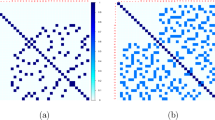Abstract
Fractional factorial designs (FFD’s) are no doubt the most widely used designs in the experimental investigations due to their efficient use of experimental runs to study many factors simultaneously. One consequence of using FFD’s is the aliasing of factorial effects. Follow-up experiments may be needed to break the confounding. A simple strategy is to add a foldover of the initial design, the new fraction is called a foldover design. Combining a foldover design with the original design converts a design of resolution r into a combined design of resolution \(r+1\). In this paper, we take the centered \(L_2\)-discrepancy \(({\mathcal {CD}})\) as the optimality measure to construct the optimal combined design and take asymmetrical factorials with mixed two and three levels, which are most commonly used in practice, as the original designs. New and efficient analytical expressions based on the row distance of the \({\mathcal {CD}}\) for combined designs are obtained. Based on these new formulations, we present new and efficient lower bounds of the \({\mathcal {CD}}\). Using the new formulations and lower bounds as the benchmarks, we may implement a new algorithm for constructing optimal mixed-level combined designs. By this search heuristic, we may obtain mixed-level combined designs with low discrepancy.
Similar content being viewed by others
References
Elsawah AM, Qin H (2014) New lower bound for centered \(L_2\)-discrepancy of four-level \(U\)-type designs. Stat Probab Lett 93:65–71
Elsawah AM, Qin H (2015a) Lee discrepancy on symmetric three-level combined designs. Stat Probab Lett 96:273–280
Elsawah AM, Qin H (2015b) A new strategy for optimal foldover two-level designs. Stat Probab Lett 103:116–126
Elsawah AM, Qin H (2015c) Mixture discrepancy on symmetric balanced designs. Stat Probab Lett 104:123–132
Elsawah AM, Qin H (2015d) Lower bound of centered \(L_2\)-discrepancy for mixed two and three levels U-type designs. J Stat Plan Inference 161:1–11
Elsawah AM, Qin H (2016a) An efficient methodology for constructing optimal foldover designs in terms of mixture discrepancy. J Korean Stat Soc. Soc 45:77–88
Elsawah AM, Qin H (2016b) Asymmetric uniform designs based on mixture discrepancy. J Appl Stat. doi:10.1080/02664763.2016.1140727
Elsawah AM, Qin H (2016c) A new look on optimal foldover plans in terms of uniformity criteria. Commun Stat Theory Methods. doi:10.1080/03610926.2015.1024862
Elsawah AM, Al-awady MA, Abd Elgawad MA, Qin H (2016) A note on optimal foldover four-level factorials. Acta Math Sin 32(3):286–296
Fang KT, Lin DKJ, Qin H (2003) A note on optimal foldover design. Stat Probab Lett 62:245–250
Fang KT, Mukerjee R (2000) A connection between uniformity and aberration in regular fractions of two-level factorials. Biometrika 87:173–198
Li W, Lin DKJ (2003) Optimal foldover plans for two-Level fractional factorial designs. Technometrics 45:142–149
Ou ZJ, Qin H, Cai X (2014) A lower bound for the wrap-around \(L_2\)-discrepancy on combined designs of mixed two- and three-level factorials. Commun Stat Theory Methods 43:2274–2285
Qin H, Ai M (2007) A note on connection between uniformity and generalized minimum aberration. Stat Pap 48:491–502
Wang B, Robert GM, John FB (2010) A note on the selection of optimal foldover plans for 16- and 32-run fractional factorial designs. J Stat Plann Inference 140:1497–1500
Acknowledgments
The authors greatly appreciate helpful suggestions of the two referees and the Associate Editor that greatly improved the paper. Elsawah is indebted to Professor Kai-Tai Fang for his help and his kind support. This work was partially supported by the UIC Research Grant (R201409) and the National Natural Science Foundation of China (Nos. 11271147, 11471135, 11471136).
Author information
Authors and Affiliations
Corresponding author
Appendix
Appendix
Proof of Theorem 1
From (3.1), we can put the uniformity criterion measured by \({\mathcal {CD}}\) based on any mixed two and three levels combined design as follows
where \(\Xi _{ijk}({{\mathfrak {P}}})=\Xi _{ijk},~\Xi _{ik}({{\mathfrak {P}}})=\Xi _{ik}\) and \(\Xi _{ik}({{\mathfrak {P}}}_f)=1+\frac{1}{2}|u_{ik}(\gamma _k)-\frac{1}{2}|-\frac{1}{2}|u_{ik}(\gamma _k)-\frac{1}{2}|^{2}\) and \(\Xi _{ijk}({{\mathfrak {P}}}_f)=1+\frac{1}{2}|u_{ik}(\gamma _k)-\frac{1}{2}|+\frac{1}{2}|u_{jk}(\gamma _k)-\frac{1}{2}|-\frac{1}{2}|u_{ik}(\gamma _k)-u_{jk}{(\gamma _k)}|.\) From the above definition of \(u_{ik}(\gamma _k)\) it is easy to show that \(\Xi _{ik}({{\mathfrak {P}}}_f)=\Xi _{ik}({{\mathfrak {P}}})\) and \(\Xi _{ijk}({{\mathfrak {P}}}_f)=\Xi _{ijk}({{\mathfrak {P}}}),\) which completes the proof. \(\square \)
Proof of Theorem 2
Following (3.3), we noted that
Then
and
Therefore, we have


Substituting (i) and (ii) into (3.3), then (3.4) holds, which completes the proof. \(\square \)
Proof of Lemma 3
Note that the above sum term can be put in the following form
where \(a=\ln \mu _1,~b=\ln \mu _2\) and \(z_{l}=a x_l+b y_l.\) Now, from Lemma 4 in Elsawah and Qin (2014), for any positive integer \(\theta ,\) we have
Then, we get
\(\square \)
Rights and permissions
About this article
Cite this article
Elsawah, A.M., Qin, H. Optimum mechanism for breaking the confounding effects of mixed-level designs. Comput Stat 32, 781–802 (2017). https://doi.org/10.1007/s00180-016-0651-9
Received:
Accepted:
Published:
Issue Date:
DOI: https://doi.org/10.1007/s00180-016-0651-9



